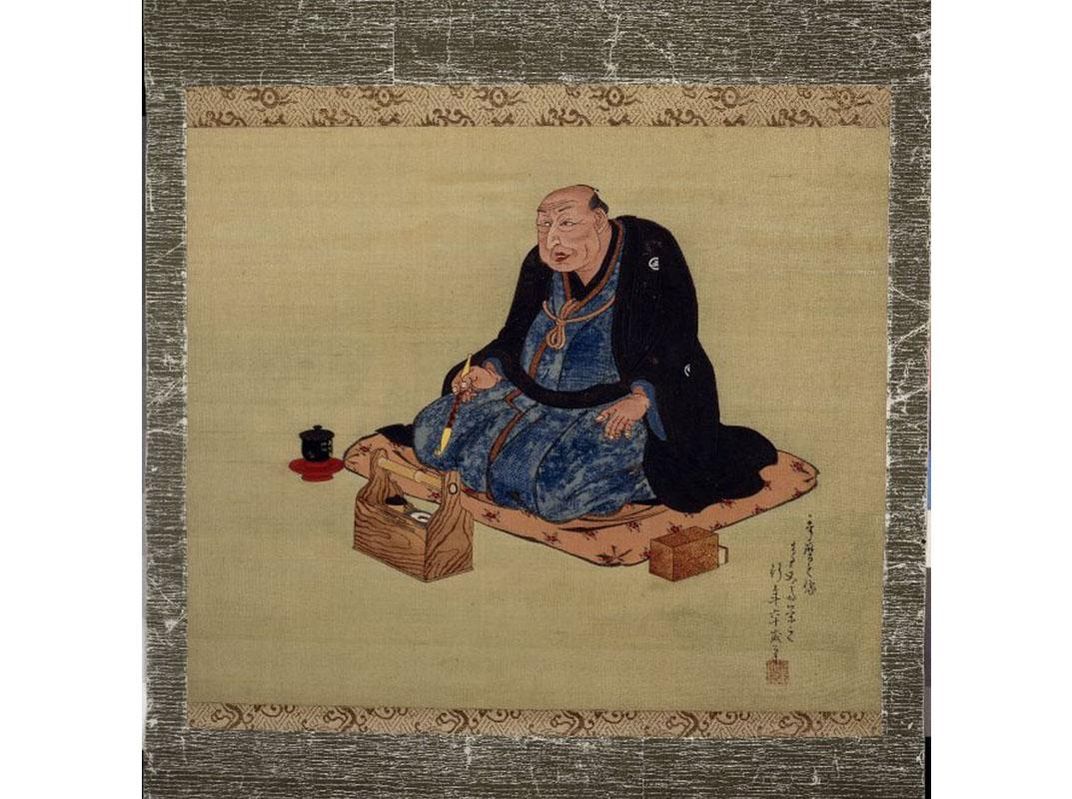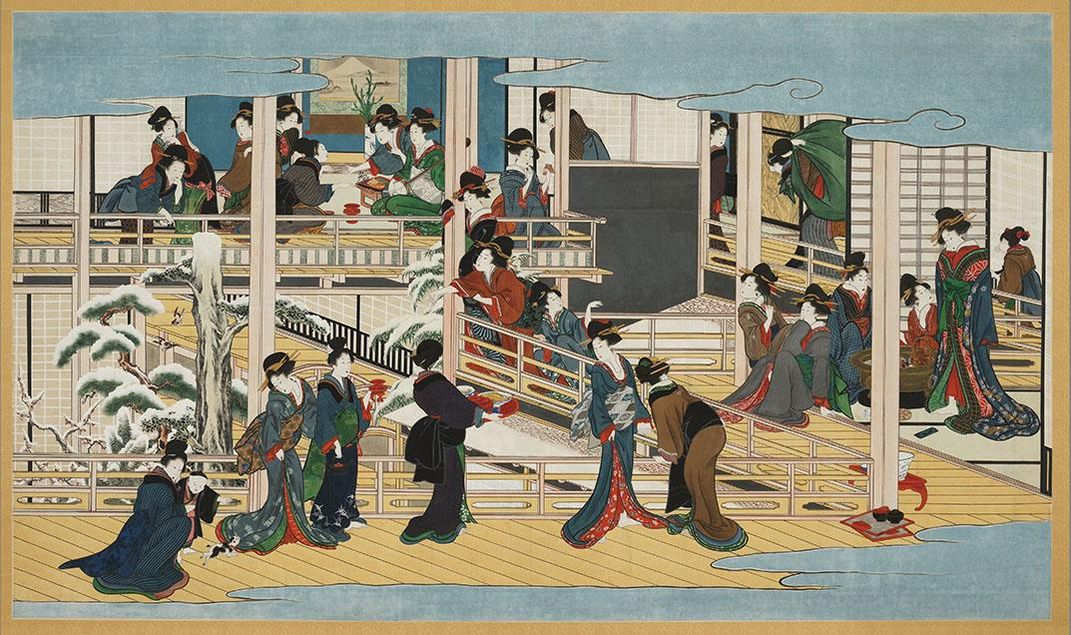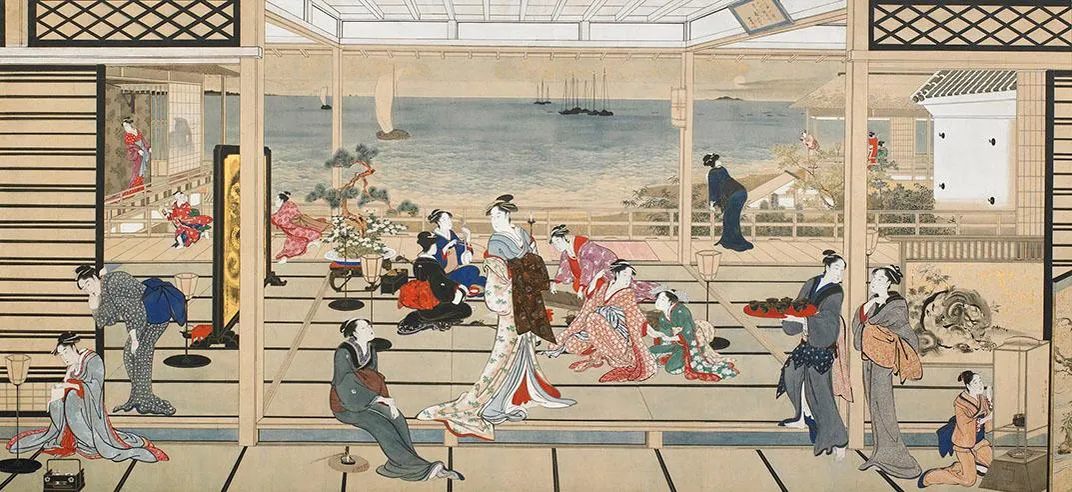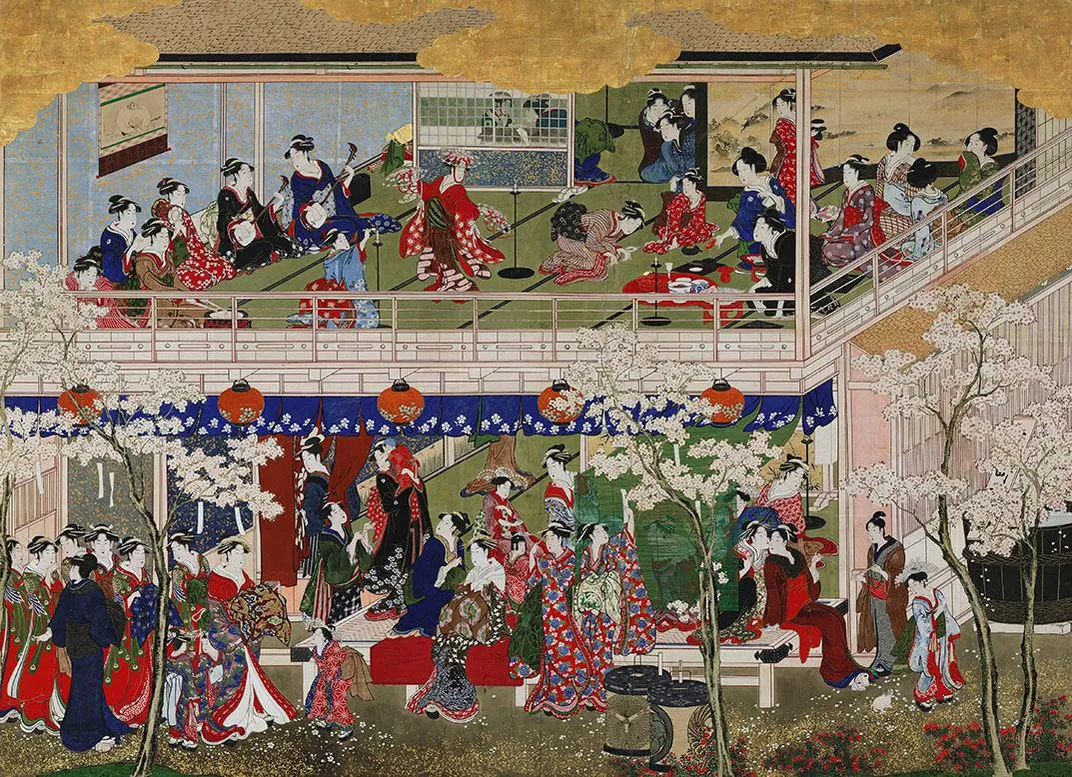This Rare Display of a Japanese Triptych is Only Usurped by the Great Mysteries Surrounding It
Don’t miss this singular showing of Kitagawa Utamaro’s three works reunited at the Sackler Gallery
A mystery-man artist in 18th-century Japan created scenes of pleasure in the ukiyo-e genre. A century later, one of three unusually large scroll paintings in a triptych that was one of his masterworks disappeared. Then, more than a hundred years on, the missing work resurfaced. Art-world sleuths have no idea where the painting was during the intervening years.
Kitagawa Utamaro (1753-1806), the mystery man, was considered one of the foremost practitioners of ukiyo-e, paintings that portray a “floating world” of pleasure. These works were particularly appealing to a rapidly industrializing West that was becoming obsessed with the East, a world seen as exotic and alluring. No matter that the graceful courtesans depicted with swooping necks, immaculate upswept hair, and beautifully draped kimonos were what we would call in contemporary parlance “sex workers.” At the time, the precision and harmony of these paintings’ style, as well as the romantic, glossy presentation of the subject matter, exerted a mighty pull on a Western world seeking escape from a period of often-frightening change.
A new exhibition at the Smithsonian's Arthur M. Sackler Gallery, “Inventing Utamaro: A Japanese Masterpiece Rediscovered,” reunites three large-scale paintings by Utamaro that were always meant to be seen together. One of the three works, Snow at Fukagawa, disappeared from public view in the late 19th century and didn’t come to light until 2014, setting in motion the art-world excitement that led to this show.
Few details of Utamaro’s life story are known. By the 1790s, the artist had achieved renown in Japan for his scenes of the pleasure quarters of old Edo, as Tokyo was called. He was carefully marketed by his publisher as a connoisseur of women and of female beauty. In a lurid incident shortly before his death, he ran into trouble with government censors. He was imprisoned and, along with several other artists, manacled for a period of 50 days.
Two of the paintings in the triptych, separated both from each other and from the newly discovered work, eventually made their way to the United States. Charles Lang Freer, founder of the Smithsonian’s Freer Gallery of Art, bought Moon at Shinagawa in 1903, and it is part of the Freer’s permanent collection. Its sibling painting, Cherry Blossoms at Yoshiwara, has been in the collections of the Wadsworth Atheneum in Hartford, Connecticut, since the 1950s. With the 2014 rediscovery of the long-lost third member of the trio, Snow at Fukagawa, by the Okada Museum of Art in the Japanese city of Hakone, the triptych can now be seen in its entirety. But this exhibition, which reunites the three works, would not always have been possible.

Charles Freer’s bequest to the museum he founded stated that works from its collection could not be loaned to other institutions, nor could outside works be displayed. Freer viewed his collection as a whole, and wanted it to be seen that way. He, of course, could not have foreseen the existence of the museum’s adjacent Arthur M. Sackler, which did not exist at the time of his death.
In the 1990s, a re-interpretation of Freer’s intentions allowed for works from the Freer Gallery to be shown at the Sackler. As James Ulak, senior curator of Japanese art at the Sackler, explains, “We can contextualize important pieces within their larger meaning. You might have a masterwork by a great artist, but now we can bring in other, complementary pieces. You see a piece in comparison to other like works and how they fit into an artist’s body of work.”
But because Freer specified that his collected works could not be loaned, the Sackler Gallery showing will be the only location where all three of the Utamaro artworks can be seen together.
In addition to the trio of paintings, the exhibition places Utamaro in a broader context with books, prints and paintings that allow a reassessment of the artist. Especially interesting are two photographs from the collection of the British Museum that reveal a portion of this triptych’s journey.
The movement known as Japonisme was a powerful force in the art market of late 19th-century Paris, and a savvy dealer named Siegfried Bing was part of a group that capitalized on the opening of Japan to the West by exporting the art of the East to the capitals of Europe and the United States. Ukiyo-e works with their stylized images of svelte, beautiful women were particularly successful. Bing, who was German by birth but lived in Paris, ran one of the most prominent galleries of Orientalia of the time. The founder of a group called La Société des Amis de l’Art Japonais (the Society of Friends of Japanese Art), he ran with a heady group of artists who shared his interests, including Mary Cassatt, Vincent van Gogh, and James McNeill Whistler.
The Utamaro paintings appeared in Paris in the 1880s, and Bing tried to broker a sale to the British Museum of two of the three–Cherry Blossoms in Yoshiwara and Snow at Fukagawa. He took photographs of two of the monumental paintings and traveled to London. Although the museum declined to purchase the works, it kept the photographs, which are on display in the current exhibition at the Sackler. Guest curator Julie Nelson Davis explains that a bit of art-world sleuthing uncovered a British Museum registrar’s notebook showing the receipt of these photographs from Bing.
But why were only two of the triptych’s three pieces offered for sale? How did Snow at Fukugawa—and that painting alone—make its way back to Japan? And where did the triptych reside up until the 1880s? It seems that the large-scale paintings were owned by a family called Zenno who lived in Togichi, north of Tokyo. “The Zenno family was very wealthy and so might have had space large enough to show one or even all three of the paintings,” notes guest curator Davis. “We also think that the Zenno family may have commissioned the paintings.”
Davis explains that it is very rare to see hanging scroll paintings this large. Normally, only standing screens or wall paintings are done on this scale. “The paintings are also unusual in that they’re not signed. That leads us to questions as to how they might have been used,” says Davis. Evidence suggests that the paintings were exhibited in a temple in 1879, not surprising due to their size. Shortly thereafter, they turned up in Paris. But questions remain, says Davis. “We are still trying to find out who exported them.”
And then there are the missing years of Fukagawa in the Snow—which has the all the makings of a Hollywood thriller. The work was last seen at an exhibition at a department store in 1948, in the middle of the occupation of Japan during World War II. Japanese department stores often house art galleries, something that might seem peculiar in the U.S. but is commonplace there. Removed from display after only a few days for reasons that remain unknown, the painting was not seen again until its discovery three years ago. The Sackler curators assume it was in a private collection, but they don’t know for sure.
“The director of the Okada Museum writes that his heart raced at seeing this painting he thought had been lost forever,” says curator Davis. “We are hoping the source will be revealed some day. This is one of those situations where you just think, ‘Wow, this is really strange.’ There are so many mysteries around this entire project.”
“Inventing Utamaro: A Japanese Masterpiece Rediscovered” is at the Sackler from April 8 to July 9, 2017. Special events related to the exhibition include a conversation with co-curators James Ulak and Julie Nelson Davis on April 8 at 2 p.m.; and performances of a Japanese Broadway-style musical from the 1970s that was centered on Utamaro’s life, June 30 at 1 p.m., July 1 at 1 and 4 p.m., and July 2 at 1 and 4 p.m.
/https://tf-cmsv2-smithsonianmag-media.s3.amazonaws.com/accounts/headshot/Smiling-Anne.jpg)



/https://tf-cmsv2-smithsonianmag-media.s3.amazonaws.com/accounts/headshot/Smiling-Anne.jpg)